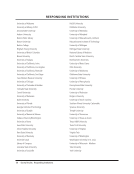SPEC Kit 335: Digital Image Collections and Services · 31
Academic departments.
Academic departments and faculty create digital images that the libraries subsequently host and manage.
Academic units: Art department, and the School of Architecture, Provost, SHANTI (Sciences, Humanities and Arts
Network of Technological Initiatives).
All units in the university contribute to the digital collections with digital images related to their units and research,
including digitized images and born-digital curated images.
Archival units across campus.
Art History department (2 responses)
Art History department negotiates purchase/use of some licensed collections on their own. They also digitize analog
images and create born-digital images that they manage on their own. A faculty member in the Anthropology
department has completed an external grant project in which he created an analog-to-digital collection that is now
managed by the Libraries.
Centre for Scholarly Communications (part of Libraries and Cultural Resources as is the Library, the Art Galleries, and the
University Press) creates, hosts, disseminates, and preserves digital image collections in a variety of platforms.
Departmental image collections (School of Art and College of Built Environments) also digitize analog images. Faculty in
multiple departments, media center staff in IT, and facilities staff create born-digital images.
Department of Art History Visual Resources Centre
Digital Conversion and Media Reformatting (responsible for all digitization services), Digital Stewardship (responsible for
digital project management).
Every college on campus could submit digital images that are born digital.
Faculty and staff from College of Agriculture and College of Architecture, Design, and Construction supply digital and/or
digitized documents for on-going local collections
Hawaiian Historical Society and Hawaii State Archives have both been involved in digitization of analog resources,
Historical Society has negotiated rights, UH Press provides electronic files of publications.
History of Art Department Visual Resources Collections College of Literature Science &Arts Museums
Humanities Division’s Visual Resource Center, which serves the Art History and other departments.
Institute Communications and Marketing (creates born-digital images). Institute Facilities Design and Construction
(creates born-digital images).
Library acquisitions and Library Metadata Services.
Media Services group of Computing &Information Services (CIS) supports instructional needs of faculty.
Monetary support to the library from Nautical Archeology for creating digital images from slides. Current exploration of
project for inclusion of born digital images from the College of Veterinary Medicine. Existing collection of born digital
radiographic images from the Biodiversity Research and Teaching Collections.
Negotiate individual agreements with image rights holders may involve University legal counsel. Create born-digital
images and digitize analog images occasionally involves cooperation with Media and Technology Services or the Office
of Marketing and Communication.
Academic departments.
Academic departments and faculty create digital images that the libraries subsequently host and manage.
Academic units: Art department, and the School of Architecture, Provost, SHANTI (Sciences, Humanities and Arts
Network of Technological Initiatives).
All units in the university contribute to the digital collections with digital images related to their units and research,
including digitized images and born-digital curated images.
Archival units across campus.
Art History department (2 responses)
Art History department negotiates purchase/use of some licensed collections on their own. They also digitize analog
images and create born-digital images that they manage on their own. A faculty member in the Anthropology
department has completed an external grant project in which he created an analog-to-digital collection that is now
managed by the Libraries.
Centre for Scholarly Communications (part of Libraries and Cultural Resources as is the Library, the Art Galleries, and the
University Press) creates, hosts, disseminates, and preserves digital image collections in a variety of platforms.
Departmental image collections (School of Art and College of Built Environments) also digitize analog images. Faculty in
multiple departments, media center staff in IT, and facilities staff create born-digital images.
Department of Art History Visual Resources Centre
Digital Conversion and Media Reformatting (responsible for all digitization services), Digital Stewardship (responsible for
digital project management).
Every college on campus could submit digital images that are born digital.
Faculty and staff from College of Agriculture and College of Architecture, Design, and Construction supply digital and/or
digitized documents for on-going local collections
Hawaiian Historical Society and Hawaii State Archives have both been involved in digitization of analog resources,
Historical Society has negotiated rights, UH Press provides electronic files of publications.
History of Art Department Visual Resources Collections College of Literature Science &Arts Museums
Humanities Division’s Visual Resource Center, which serves the Art History and other departments.
Institute Communications and Marketing (creates born-digital images). Institute Facilities Design and Construction
(creates born-digital images).
Library acquisitions and Library Metadata Services.
Media Services group of Computing &Information Services (CIS) supports instructional needs of faculty.
Monetary support to the library from Nautical Archeology for creating digital images from slides. Current exploration of
project for inclusion of born digital images from the College of Veterinary Medicine. Existing collection of born digital
radiographic images from the Biodiversity Research and Teaching Collections.
Negotiate individual agreements with image rights holders may involve University legal counsel. Create born-digital
images and digitize analog images occasionally involves cooperation with Media and Technology Services or the Office
of Marketing and Communication.


































































































































































































